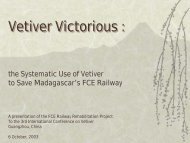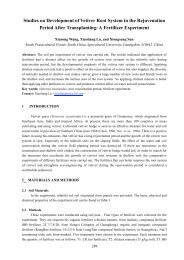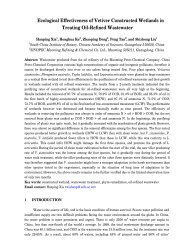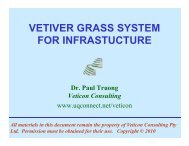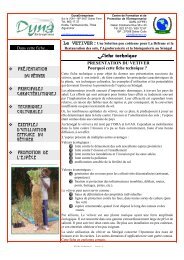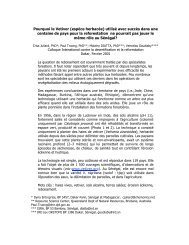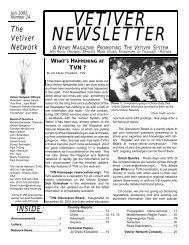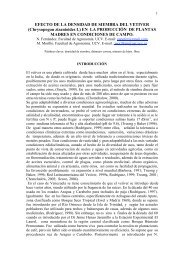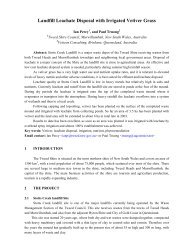Vetiver in Thailand: General Aspects and Basic Studies - The Vetiver ...
Vetiver in Thailand: General Aspects and Basic Studies - The Vetiver ...
Vetiver in Thailand: General Aspects and Basic Studies - The Vetiver ...
You also want an ePaper? Increase the reach of your titles
YUMPU automatically turns print PDFs into web optimized ePapers that Google loves.
<strong>Vetiver</strong> <strong>in</strong> <strong>Thail<strong>and</strong></strong>: <strong>General</strong> <strong>Aspects</strong> <strong>and</strong> <strong>Basic</strong> <strong>Studies</strong>Nualchavee RoongtanakiatAbstractIn <strong>Thail<strong>and</strong></strong>, the study <strong>and</strong> research on vetiver began after His Majesty theK<strong>in</strong>g had expressed his impression on vetiver <strong>in</strong> 1992. From the study by theDepartment of L<strong>and</strong> <strong>and</strong> Development, the guidel<strong>in</strong>e for plant<strong>in</strong>g Thai vetiver, FaekDon (upl<strong>and</strong> vetiver) <strong>and</strong> Faek Hom (lowl<strong>and</strong> vetiver) <strong>in</strong> various soil types <strong>and</strong>regions was distributed nationwide, which was very useful for the promotion <strong>and</strong>extension of the vetiver technology. <strong>The</strong> basic research is an essential tool forutiliz<strong>in</strong>g vetiver efficiently <strong>and</strong> many projects were carried out dur<strong>in</strong>g 1993-1994accord<strong>in</strong>g to the first master plan of the ORDPB. Some achievements <strong>in</strong> basicresearch <strong>in</strong> the area of genetics, plant development <strong>and</strong> breed<strong>in</strong>g, vetiver <strong>and</strong> soilfertility as well as phytoremediation were obta<strong>in</strong>ed by Kasetsert University staff <strong>and</strong>have been described here<strong>in</strong>. <strong>The</strong> results of these studies show the importance of basicresearch <strong>and</strong> that we need to cont<strong>in</strong>ually seek more <strong>in</strong>formation about the “Miracle ofvetiver”.Introduction<strong>Thail<strong>and</strong></strong>’s abundant natural resources have been used <strong>in</strong>tensively for thedevelopment of the country. With the rapid growth of the population from 55.8million <strong>in</strong> 1990 to 65.5 million <strong>in</strong> 2006 (National Statistics Offices, 2006), thedem<strong>and</strong> on natural resources have dramatically <strong>in</strong>creased. This has not only causedthe depletion of such resources, but also created environmental pollution problems.Soil <strong>and</strong> water resources, the important factor <strong>in</strong> all liv<strong>in</strong>g organisms, are significantlyaffected by economic <strong>and</strong> agricultural development. Soil deterioration is severe dueto the <strong>in</strong>appropriate use of soil resources. <strong>Vetiver</strong>, the miracle grass, is a means to usenature to take care of itself. His Majesty K<strong>in</strong>g Bhumibol Adulyadej has promoted the<strong>in</strong>itiative of conduct<strong>in</strong>g exam<strong>in</strong>ations of us<strong>in</strong>g vetiver for soil <strong>and</strong> water conservations<strong>in</strong>ce 1991. <strong>The</strong>se experiments have showed that vetiver could prevent soil erosionbecause of its deep <strong>and</strong> widely spread<strong>in</strong>g root system, penetrat<strong>in</strong>g deep <strong>in</strong>to the soil. Italso conserves soil water <strong>and</strong> nutrients which are favorable for all activities. HisMajesty periodically added to these orig<strong>in</strong>al <strong>in</strong>itiatives by suggest<strong>in</strong>g the use ofvetiver for slope stabilization, erosion control, environmental improvement <strong>and</strong>protection, disaster prevention, etc., this has s<strong>in</strong>ce then, brought about the studies onvetiver with<strong>in</strong> various organizations.-----------------------------------------------------Department of Applied Radiation <strong>and</strong> Isotopes, Faculty of Science, KasetsartUniversity, Bangkok, <strong>Thail<strong>and</strong></strong>.
2Vitiver <strong>in</strong> <strong>Thail<strong>and</strong></strong>Faek Don (upl<strong>and</strong> vetiver) <strong>and</strong> Faek Hom (lowl<strong>and</strong> vetiver)<strong>Vetiver</strong> is generally known to be orig<strong>in</strong>ated <strong>in</strong> India. It is also found widelydistributed naturally <strong>in</strong> all regions of <strong>Thail<strong>and</strong></strong>. From the botanical exploration, itcould be concluded that there are two species of vetiver <strong>in</strong> <strong>Thail<strong>and</strong></strong>, namely <strong>Vetiver</strong>ianemoralis A. Camus <strong>and</strong> <strong>Vetiver</strong>ia zizanioides Nash.<strong>Vetiver</strong>ia nemoralis, the local vetiver, is distributed ma<strong>in</strong>ly <strong>in</strong> the South-eastAsian region. In <strong>Thail<strong>and</strong></strong> it is commonly found <strong>in</strong> the dry area with moderate tostrong sunlight <strong>and</strong> well-dra<strong>in</strong>ed soil, so it is called upl<strong>and</strong> vetiver or “Faek Don” <strong>in</strong>Thai (Faek = vetiver <strong>and</strong> Don = upl<strong>and</strong>). <strong>The</strong> leaf of Faek Don is 35-80 cm long <strong>and</strong>0.4-0.8 cm wide <strong>and</strong> pale green <strong>in</strong> color. <strong>The</strong> color of the lower leaf surface is thesame as that of the upper surface but somewhat paler. <strong>The</strong> septum can not be seen,whereas the midrib is hard <strong>and</strong> forms the prom<strong>in</strong>ent ridge. <strong>The</strong> leaf texture is coarselyrough <strong>and</strong> slightly waxy. Its roots have no fragrance <strong>and</strong> can be 80-100 cm long <strong>in</strong>one year old vetiver.<strong>Vetiver</strong>ia zizanioides or lowl<strong>and</strong> vetiver, is called “Faek Hom” <strong>in</strong> Thai (Hom= fragrant) because of its fragrant root which can be used for volatile oil extraction.Faek Hom is able to adapt very well <strong>and</strong> grow well <strong>in</strong> various environmentalconditions. Its leaf is 45-100 cm long, 0.6-1.2 cm wide, curved on the upper surface<strong>and</strong> flat near the apex with a smooth <strong>and</strong> waxy texture. <strong>The</strong> leaf color is dark green<strong>and</strong> the lower surface is paler than the upper surface. <strong>The</strong> septum can be seen clearlyespecially at the base <strong>and</strong> middle part of the blade, whereas the midrib is not clearlyseen. <strong>The</strong> roots of Faek Hom are longer than those of Faek Don, the one year oldvetiver can produce over 1 meter long roots.Both Faek Don <strong>and</strong> Faek Hom pose dist<strong>in</strong>ct ecological variation which makesthem adaptable to different habitats. <strong>The</strong>refore, they are commonly found <strong>in</strong> allregions of <strong>Thail<strong>and</strong></strong> <strong>and</strong> there are many ecotypes. Thai vetiver ecotype was namedafter the prov<strong>in</strong>ce where it was first found, e.g., Ratchaburi, Surat Thani, Roi Et, Loei,Kamphaeng Phet. <strong>The</strong> Department of L<strong>and</strong> Development has done a comparativestudy of 28 vetiver ecotypes, 11 ecotypes of Faek Don <strong>and</strong> 17 ecotypes of Faek Hom.As the result, 10 ecotypes have been proved suitable to grow <strong>in</strong> various soil types <strong>and</strong>regions (Tables 1 <strong>and</strong> 2) (ORDPB, 2000). This <strong>in</strong>formation is useful for research <strong>and</strong>development on vetiver <strong>in</strong> <strong>Thail<strong>and</strong></strong>.Table 1. <strong>Vetiver</strong> ecotypes suitably grow <strong>in</strong> various soil typesSoil type Faek Don Faek HomS<strong>and</strong>y soil Nakhon Sawan, Kamphaeng Kamphaeng Phet 2, Songkhla 3Phet 1, Roi Et, RatchaburiClay loam soil Loei, Nakhon Sawan, Ratchaburi, Surat Thani, Songkhla 3Kamphaeng Phet 1, PrachuapKhiri KhanLeterite soil Prachuap Khiri Khan, Loei Kamphaeng Phet 2, Songkhla 3Surat Thani, Sri Lanka
3Table 2. <strong>Vetiver</strong> ecotypes suitably grow <strong>in</strong> the regionsRegion Faek Don Faek HomNorthNakhon Sawan, Kamphaeng Sri LankaPhet 1Northeast Roi Et Songkhla 3Central region<strong>and</strong> EastRatchaburi, Kamphaeng Phet 1,Prachuap Khiri KhanKamphaeng Phet 2, Songkhla 3,Surat ThaniSouthSongkhla 3, Surat ThaniResearch <strong>and</strong> DevelopmentAfter His Majesty had delivered his <strong>in</strong>itiative on vetiver, many agenciespromptly responded to undertake researches <strong>and</strong> development on vetiver utilization.<strong>The</strong> Office of the Royal Development Projects Board (ORDPB) has been the centralagency <strong>in</strong> coord<strong>in</strong>at<strong>in</strong>g <strong>and</strong> monitor<strong>in</strong>g the projects to follow His Majesty’sguidel<strong>in</strong>es. At present, there are 41 agencies which are cooperat<strong>in</strong>g with the ORDPB<strong>in</strong> research <strong>and</strong> development. <strong>The</strong> theme of works has been done follow<strong>in</strong>g theORDPB’s master plans. <strong>The</strong> first master plan which was active dur<strong>in</strong>g 1993-1994,emphasized on basic <strong>and</strong> applied researches. <strong>The</strong> second master plan (1997-1999)aimed to cont<strong>in</strong>ue the research respond<strong>in</strong>g to His Majesty’s advices <strong>and</strong> theknowledge dissem<strong>in</strong>ation on utilization of vetiver to the target groups. <strong>The</strong> thirdmaster plan (2002-2006), was concerned with extension <strong>and</strong> promotion of us<strong>in</strong>gvetiver for soil <strong>and</strong> water conservation as well as natural resource <strong>and</strong> environmentalrehabilitation with government organizations, private sectors, societies <strong>and</strong> farmerscooperation (ORDPB, 2005). <strong>The</strong> ORDPB also f<strong>in</strong>ancially supported research <strong>and</strong>development on vetiver. Dur<strong>in</strong>g 1993-1999, there were 197 research projects underthe ORDPB support <strong>in</strong> the areas of basic research, soil <strong>and</strong> water conservation <strong>and</strong>vetiver utilization (ORDPB, 2005). Many of them have been completed <strong>and</strong> haveachieved their goals while many are ongo<strong>in</strong>g. Many of the basic research works weredone dur<strong>in</strong>g 1993-1994 to follow the master plan of the ORDPB. However, it is stillimportant to support the applied work on vetiver which is wildly exp<strong>and</strong>ed.Role of Kasetsart UniversityKasetsart University (KU) has the policy to serve the royal projects forimprov<strong>in</strong>g the well-be<strong>in</strong>g of Thai people on the basis of self-sufficiency. <strong>The</strong> studieson vetiver began at KU <strong>in</strong> 1992. Up to the present time, there have been 79 researchprojects done by KU staff members <strong>in</strong> many areas <strong>in</strong>clud<strong>in</strong>g the basic research. <strong>The</strong>results from the applied research works could be transferred to the target groups whilethe knowledge <strong>and</strong> <strong>in</strong>formation obta<strong>in</strong>ed from the basic research works could revealmore on the nature of vetiver <strong>in</strong> which some results of these achievements are givenas follows:
4Genetic studyIn general, the ecotype <strong>and</strong> phenotype characterizations were used to identifyvetiver <strong>in</strong> <strong>Thail<strong>and</strong></strong>. However, the m<strong>in</strong>or nucleotide variations may also triggermorphological, physiological <strong>and</strong> biological differences. Srifah et al. (2002) haveconducted an experiment for genome analysis of 42 Thai vetiver ecotypes. <strong>The</strong> resultcould show that both s<strong>in</strong>gle-str<strong>and</strong> conformational polymorphism (SSCP) <strong>and</strong> r<strong>and</strong>omamplified polymorphic DNA (RAPD) analyses for DNA polymorphism are sufficientto dist<strong>in</strong>guish each ecotype of Faek Don <strong>and</strong> Faek Hom.For karyomorphological study, Kongpraphon et al. (2003) developed acytological technique to display chromosome morphology <strong>in</strong> cells obta<strong>in</strong>ed from theroot tip of 15 Thai vetiver ecotypes. It was found that all studied ecotypes had thesame chromosome number of 2n = 2x = 20. <strong>The</strong> variation <strong>in</strong> satellite chromosomes <strong>in</strong>terms of number <strong>and</strong> morphology was evident <strong>in</strong> six ecotypes. <strong>The</strong> total chromosomelength varied from 1.5-8.4 micrometers. <strong>The</strong> karyotype consisted of metacentric <strong>and</strong>submetacentric chromosomes, all of which were nearly symmetrical. Localization ofthe heterochromatic regions on the chromosome was achieved by modified C-b<strong>and</strong><strong>and</strong> N-b<strong>and</strong>. All the pairs of chromosomes were identified by these b<strong>and</strong><strong>in</strong>g patterns,along with their length <strong>and</strong> arm ratios. <strong>The</strong>y can be used as the basis for reproduciblekaryotypes <strong>and</strong> for detect<strong>in</strong>g chromosomal relationships among ecotypes. Eachecotype showed at least one chromosome with a whole dark b<strong>and</strong>, <strong>in</strong>dicat<strong>in</strong>g aconstitutive heterochromat<strong>in</strong>. <strong>The</strong> rema<strong>in</strong>der <strong>in</strong>dicated variation patterns from ecotypeto other ecotypes of the some fa<strong>in</strong>t <strong>and</strong> dark b<strong>and</strong>s.To underst<strong>and</strong> the background of vetiver chromosome behavior, Kongpraphonet al. (2005) observed chromosome association <strong>in</strong> various stages of meiotic celldivision <strong>and</strong> correlated them with the previous studies. <strong>The</strong> result showed that themeiotic division <strong>in</strong> five vetiver ecotypes studied seemed to be normal with only a fewof them show<strong>in</strong>g abnormality. Numerous micronuclei appeared to be related with thenumber of satellite chromosomes. <strong>The</strong> ecotypes with 1-2 satellite chromosomes hadnumerous micronuclei <strong>in</strong> meiotic cells while the ecotypes without satellitechromosome appeared to have no micronuclei.Plant development <strong>and</strong> breed<strong>in</strong>g study<strong>The</strong> <strong>in</strong>formation on vetiver development is important for successfulcultivation. Kaveeta et al. (2000) studied shoot apex development, rate of leafprimordial <strong>in</strong>itiation <strong>and</strong> the rate of leaf appearance on ma<strong>in</strong> stem of four vetiverecotypes namely; Surat Thani, Ratchaburi, Sri Lanka <strong>and</strong> Kamphaeng Phet 1. <strong>The</strong>results revealed that the four ecotypes had similar patterns of apex development, butdiffered substantially <strong>in</strong> the duration <strong>and</strong> rate of each development. All four ecotypeshad similar l<strong>in</strong>ear relationships <strong>in</strong> the leaf primordial production <strong>and</strong> performed anexponential relationship with faster leaf production for the first 150 days; thereafter,the rate would slow down. <strong>The</strong>y produced tillers that fitted to the quadraticrelationship by which slow tiller<strong>in</strong>g was observed dur<strong>in</strong>g the early stage ofdevelopment.
5Tissue culture technique has been used for veitver propagation as it canproduce large quantity of plantlets <strong>and</strong> it is convenient for transportation for plant<strong>in</strong>g<strong>in</strong> other places. In order to promote rapid multiplication, the Department of Botanyresearch team successfully developed this technique us<strong>in</strong>g lateral or term<strong>in</strong>al buds ofvetiver with a 70 % survival rate of plantlets. S<strong>in</strong>ce 2002, they have propagated <strong>and</strong>distributed more than 100,000 vetiver seedl<strong>in</strong>gs each year to various governmental<strong>and</strong> non-governmental organizations for the promotion of vetiver technology.With tissue culture technique, Na Nakorn et al. (2000) experimented to <strong>in</strong>ducesalt tolerance <strong>in</strong> n<strong>in</strong>e vetiver ecotypes. From the results, the 50-gray gamma irradiatedcalli of Kamphaeng Phet 1 ecotype exhibited maximum degree of salt tolerance. <strong>The</strong>calli could tolerate up to 4% NaCl, higher than those of without radiation at 3%NaCl. <strong>The</strong> plantlet regeneration of salt tolerant calli is the next goal of this researchteam.Plant cells resistant to herbicides have been produced by <strong>in</strong> vitro selection <strong>and</strong>successfully used <strong>in</strong> the study of herbicide resistant plant production. Prasertsongkunet al. (2002) performed an experiment to select vetiver cells suspension resistant toglufos<strong>in</strong>ate <strong>and</strong> <strong>in</strong>vestigated the mechanisms of resistance. <strong>The</strong>y could select vetivercells which were 170-fold resistant to glufos<strong>in</strong>ate, compared to the susceptible cells.<strong>The</strong> glutam<strong>in</strong>e synthetase (GS) activity of the resistant cells was twice as high as thatof the susceptible cells. <strong>The</strong>se results showed that the resistance of the selected vetivercell suspension to glufos<strong>in</strong>ate is ma<strong>in</strong>ly due to <strong>in</strong>creas<strong>in</strong>g GS activity <strong>and</strong> its decrease<strong>in</strong> sensitivity to the herbicide.<strong>Vetiver</strong> <strong>and</strong> soil fertility studySoil fertility, which is an important factor for agricultural productivity, is<strong>in</strong>fluenced by parent material <strong>and</strong> <strong>in</strong>appropriate soil management practices. Manyresearch works on soil fertility improvement by vetiver have been <strong>in</strong>vestigated. <strong>The</strong>experiment done by Roongtanakiat et al. (2000) revealed that vetiver mulch<strong>in</strong>gconserved topsoil moisture <strong>and</strong> <strong>in</strong>creased available-N, available-P <strong>and</strong> extractable-K.<strong>The</strong> further experiment showed that one tonne of dry vetiver shoot buried at the depthof 10 cm would yield m<strong>in</strong>eral N, available-K upto 4.4, 2.2 <strong>and</strong> 20.5 kg while that lefton the soil surface would yield only 0.85, 0.74 <strong>and</strong> 7.20 kg, respectively (Chairoj <strong>and</strong>Roongtanakiat, 2004).<strong>Vetiver</strong> cultivation could improve some chemical <strong>and</strong> physical properties ofsoil. Tantachasatid (2003) cultivated vetiver <strong>in</strong> laterite soil, Phon Phisai soil series.After n<strong>in</strong>e months, a certa<strong>in</strong> level of improvement of soil properties such as pH,organic matter, available-P, extractable-K, aggregate stability, bulk density,permeability <strong>and</strong> available water capacity, could be achieved by cultivation of vetiveras a sole crop <strong>and</strong> mixed cropp<strong>in</strong>g with cover crops.Soil microorganisms associated with vetiver are important for vetiver growth<strong>and</strong> development especially <strong>in</strong> <strong>in</strong>fertile soil. <strong>The</strong>y produce nutrient sources <strong>and</strong> <strong>in</strong>duceplant growth hormones for vetiver. Techap<strong>in</strong>yawat et al. (2000) reported that VAmycorrhiza <strong>in</strong>oculated to vetiver significantly <strong>in</strong>creased plant biomass <strong>and</strong> the nutrientuptake. With isotope tracer technique, Techap<strong>in</strong>yawat et al. (2002) studied the effectsof 3 species of arbuscular mycorrhizal fungi: Acaulospora scrobiculata, Glomus sp.,Glomus aggregatum <strong>in</strong> comb<strong>in</strong>ations with phosphate fertilizer on P-uptake of vetiver.
6<strong>The</strong>y reported that arbuscular mycorrhizal fungi significantly <strong>in</strong>creased P-concentration, P-uptake, %P derived from fertilizer <strong>and</strong> P-availability <strong>in</strong> vetiver. At60 kg P 2 O 5 ha -1 level of application, the highest % P P derived from fertilizer, P-availability, <strong>and</strong> total P-uptake obta<strong>in</strong>ed from A. scrobiculata, whereas G.Aggregatum treatments with no P-supplied gave the greatest P-concentration.Increas<strong>in</strong>g phosphate fertilizer up to 90 kg P 2 O 5 ha -1 , resulted <strong>in</strong> non-significantchanges of P-uptake <strong>and</strong> P-availability <strong>in</strong> plants.Phytoremediation studyPhytoremediation is well known for its environmentally friendly <strong>and</strong><strong>in</strong>expensive technology. Many researches showed that vetiver could be used asphotoremidiation plant, especially for decontam<strong>in</strong>at<strong>in</strong>g heavy metal from soil <strong>and</strong>water. Roongtanakiat <strong>and</strong> Chairoj (2001a, 2001b) evaluated the uptake potential ofthree vetiver ecotypes for Mn, Zn, Cu, Cd, <strong>and</strong> Pb. <strong>The</strong> results showed that theseheavy metals did not affect the growth of vetiver. At harvest<strong>in</strong>g of 60 days after heavymetals application, Ratchaburi ecotype gave highest shoot dry weight <strong>and</strong> hadsignificantly higher Mn, Zn, <strong>and</strong> Cd amounts <strong>in</strong> shoots than Surast Thani <strong>and</strong>Kamphaeng Phet ecotypes. However, Ratchaburi <strong>and</strong> Kamphaeng Phet showedsimilar Cu uptake. <strong>The</strong> concentration of heavy metals <strong>in</strong> shoot harvested at 120 dayswas lower than that harvested at 60 days due to dilution effect. This showed thatvetiver is not a heavy metal hyperaccumulator plant. <strong>The</strong>refore, the researcherssuggested that when utiliz<strong>in</strong>g vetiver for the phytoremediation of heavy metalscontam<strong>in</strong>ated soil, the above ground biomass should be regularly cut to stimulateregrowth <strong>and</strong> the translocation of heavy metals to shoots.Polluted soil from l<strong>and</strong>fill leachate is an environmental problem of large cities.<strong>The</strong> l<strong>and</strong>fill leachate usually has high content of pollutants, especially heavy metals<strong>and</strong> other harmful substances. Roongtanakiat <strong>and</strong> Chairoj (2001a, 2001b) showed thatthe leachate strength of l<strong>and</strong>fill affected vetiver growth <strong>and</strong> heavy metals uptake. <strong>The</strong>vetiver treated with 100% leachate could not survive 80-85 days after plant<strong>in</strong>g.<strong>Vetiver</strong> uptook more heavy metals as the strength of leachate <strong>in</strong>crease.<strong>The</strong> results from an experiment us<strong>in</strong>g vetiver for wastewater treatmentconducted by Sipen et al. (1997) <strong>in</strong>dicated the possibility of vetiver as a biologicalwastewater treatment. Roongtanakiat <strong>and</strong> Tangruangkiat (2006) hydroponicallycultivated three vetiver ecotypes <strong>in</strong> four types of <strong>in</strong>dustrial wastewater. <strong>The</strong> resultsshowed that the concentration of heavy metal <strong>in</strong> waste water played an important role<strong>in</strong> vetiver growth. <strong>The</strong> vetiver absorbed Fe>Mn>Zn>Cu>Pb, respectively <strong>and</strong> theyconcentrated more <strong>in</strong> vetiver root than <strong>in</strong> shoot. Among the three vetiver ecotypes,Sri Lanka had best growth <strong>and</strong> the highest heavy metals removal efficiencies.ConclusionFollow<strong>in</strong>g His Majesty’s <strong>in</strong>itiation, numerous research work <strong>and</strong> practicalapplications on vetiver were conducted by many organizations <strong>in</strong>clud<strong>in</strong>g KasetsartUniversity. <strong>The</strong> results showed useful <strong>in</strong>formation on the nature of vetiver, whichhelps us with the utilization of vetiver. However, there are still more questions to beanswered, e.g. what makes vetiver work so well, how to enhance the potential for
7phytoremidiation, how to obta<strong>in</strong> shade tolerant vetiver <strong>and</strong> cold tolerant vetiver, howsoil microorganism associate with vetiver. <strong>Basic</strong> research is still required to elucidatemore on vetiver.ReferencesKaveeta, L., S. Ratchnee, M. Na Nakorn, R. Kaveeta, W. Weerachai <strong>and</strong> W.Charoenrungrat. 2000. Development variation of four setected vetiverecotypes, p. 425-431 In Proceed<strong>in</strong>gs of the Second International Conferenceon <strong>Vetiver</strong>, <strong>Thail<strong>and</strong></strong>. 18-22 January 2000.Kongprakhon P., N. Sangduen <strong>and</strong> K. Namwongprom. 2003. Karyomorphologicalstudy of veiver germplasm <strong>in</strong> <strong>Thail<strong>and</strong></strong>. AU J.T. 7(2): 75-80.Kongprakhon P., N. Sangduen, V. Hongtrakul <strong>and</strong> K. Namwongprom. 2005. Meiosisof vetiver germplasm <strong>in</strong> <strong>Thail<strong>and</strong></strong>. AU J.T. 9(1): 9-14.National Statistical Office. Estimated <strong>Thail<strong>and</strong></strong> Population 1990-2020. Availablesource: http://service.nso.go.th/nso/data/data23/stat_23/toc_1/1.1.4-2.xlsJuly 11, 2006.ORDPB, Office of the Royal Development Projects Board. 2000, Factual Tips about<strong>Vetiver</strong> Grass. ORDPB, Bangkok.ORDPB 2005. Operation of the Development <strong>and</strong> Promotion of the Utilization of<strong>Vetiver</strong> Grass under His Majesty’s Initiative Project dur<strong>in</strong>g the Third MasterPlan (B.E. 2545-2549). ORDPB. Bangkok. (<strong>in</strong> Thai)Phasersongkun, S., N. Sangduen, S. Suwanwong, V. Santisopasri <strong>and</strong> H. Matsumoto.2002. Increased activity <strong>and</strong> reduced sensitivity of glutam<strong>in</strong>e synthetase <strong>in</strong>glufos<strong>in</strong>ate-resistant vetiver (<strong>Vetiver</strong>ia zizanioides Nash) cells. Weed Biol.Manage, 2(4) 171-176.Roongtanakiat, N., P. Chairoj <strong>and</strong> S. Chookhao. 2000. Fertility improvement ofs<strong>and</strong>y soil by vetiver grass mulch<strong>in</strong>g <strong>and</strong> compost. Kasetsart J. (Nat. Sci.)34: 332 –338.Roongtanakiat, N. <strong>and</strong> P. Chairoj. 2001a. Uptake potential of some heavy metals byvetiver grass. Kasetsart J. (Nat. Sci.) 35: 46-50.Roongtanakiat, N. <strong>and</strong> P. Chairoj. 2001b. <strong>Vetiver</strong> grass for the remediation of soilcontam<strong>in</strong>ated with heavy metals. Kasetsart J. (Nat. Sci.) 35: 433-440.Roongtanakiat, N., T. Nirunrach, S. Chanyotha <strong>and</strong> D. Hengchavanich. 2003. Uptakeof heavy metals <strong>in</strong> l<strong>and</strong>fill leachate by vetiver grass. Kasetsart J. (Nat.Sci.)37:168-175.Roongtanakiat, N. <strong>and</strong> S. Tangruangkiat. 2006. Utilization of vetiver technologyremoval heavy metals from <strong>in</strong>dustrial wastewater. (<strong>in</strong> press)Srifah, P., B. Pomthong, V. Hongtrakul <strong>and</strong> N. Sangduen. 2000. DNApolymorphisms generation by s<strong>in</strong>gle-str<strong>and</strong> conformational polymorphism <strong>and</strong>r<strong>and</strong>om amplified polymorphic DNA technique are useful as tools for Thaivetiver genome analysis, p. 411-415 In Proceed<strong>in</strong>gs of the SecondInternational Conference on <strong>Vetiver</strong>. <strong>Thail<strong>and</strong></strong>. 18-22 January 2000.Sripen, S., T. Komkris, S. Techap<strong>in</strong>yawat, S. Chatawat, S. Masuthon <strong>and</strong> M.Rungsuk. 1996. Growth potential of vetiver grass <strong>in</strong> relation to the nutrients <strong>in</strong>wastewater of Petchburi. In Abstracts of the International Conference toCommemorate the 50 th Anniversary (Golden Jubilee) Celebrations of HisMajesty the K<strong>in</strong>g of <strong>Thail<strong>and</strong></strong>’s Accession to the Throne. <strong>Thail<strong>and</strong></strong>. 4-8February 1996.
8Tantachasatid, P. 2003. Effect of vetiver grass <strong>and</strong> cover crops on some properties ofPhon Phisai soil series. M.S. thesis, Kasetsart University.Techap<strong>in</strong>yawat, S., P. Suwanarit, P. Pakkong, N. S<strong>in</strong>buathong <strong>and</strong> P. Sumthong. 2000.Selection of effective vesical-arbuscular mycorrhiza fungi on growth <strong>and</strong> nutrientuptake of vetiver. In Abstracts of the International Conference to Commemoratethe 50 th Anniversary (Golden Jubilee) Celebrations of His Majesty the K<strong>in</strong>g of<strong>Thail<strong>and</strong></strong>’s Accession to the Throne. <strong>Thail<strong>and</strong></strong>. 4-8 February 1996.Techap<strong>in</strong>yawat, S., P. Pakkong, P. Suwanarit <strong>and</strong> P. Sumthong. 2002. Effects of arbuscularmycorrhiza <strong>and</strong> phosphate fertilizer on phosphorus uptake of vetiver us<strong>in</strong>g nucleartechnique. Kasetsart J. (Nat.Sci.) 36: 381-391.




